A lot of people seem to have had negative encounters with roosters. Stories about roosters mating hens every 10 minutes, crowing at 3 am, picking fights with the dog, or killing cockerels are disturbing. This is not how a rooster should behave.
I'm going to be using my 2 Buff Orpington roo's as models for this article, 'cause they fit the bill of a good rooster quite well. Their names are Buffulf and Orpulf.

Back To The Roots
In the wild, a rooster's job is to protect the flock. He guides the hens to food sources, finds good nest spots for his hens, warns about enemies from the ground and air, and of course, fertilizes the eggs.
Imagine if a wild rooster spent all his time mating the hens. Not only would he be distracted from looking for predators, but he'd also spend an enormous amount of energy on a useless activity (Yes, useless, a hen collects the sperm inside and can store it for weeks. Ergo, mating her a couple of times a day should be more than sufficient), and even hinder the hens from feeding and possibly injuring them by ripping out their feathers. Does that sound productive?
A wild rooster would not pick fights with everyone and everything. In the entire animal kingdom, males tend to avoid fighting at all costs. They've developed elaborate displays of horns, colors, and dances to measure strength without resorting to physical violence. Every fight is a risk for injuries, even for the winner. The expression "pick your battles" is rule number one for animals in the wild. A wild rooster doesn't have access to antibiotics, bandages, or pain killers, and while waiting for his wounds to heal, his flock is without his protection.

Buffulf being a good protector, walking first. The ladies trust him and follow along.
Crowing
Crowing functions as a call to the flock to get up and start moving (it's 6 am, time for breakfast), to locate members of the flock (marco – polo) and a means to warn other chicken flocks nearby of their presence (yo, neighbor, I'm over here!). Crowing attracts predators, so every time a rooster crows, it's a potential risk. This is actually used as a way to demonstrate strength, not only by roosters but other birds as well. A bird who's not afraid to call out his presence is one that's confident he'll escape any predators that come his way. Ergo, the ladies see a crowing rooster as a healthy specimen.
The rooster's crowing is one of the most significant behaviors that set the domestic chicken apart from its ancestors. The domestic rooster crows quite frequently, loud and long, whereas the RJF is satisfied with a quick morning wake-up call. It might be difficult to see with today's consumption of eggs and chicken, but it's believed that food was not the primary reason for the domestication of chickens. They were used for cockfighting, ceremonial purposes, and even ornamental. The rooster was revered in many ancient cultures, for his bravery and protection skills and for his morning crow. The rooster's crow was considered a good start of the day, and a noble sound. They therefore unconsciously selectively bred roosters to crow both more and longer. It's a bit sad to think that a crow that was once revered, now is looked upon as a pest. The rooster crows due to an internal clock, but also in relation to light and nearby crowing, meaning that this behavior is a cause of both genetic markers and external stimuli.

Crowing. Roosters love it, neighbors hate it.
Genetically encoded behavior
I feel that a lot of people tackle the aggression and "misbehaving" in roosters from the wrong end. What if the rooster wasn't aggressive or misbehaving in the first place? A lot of behaviors are encoded in the DNA. Animals do the strangest things (in our eyes) without no one telling them to do so. Grebe ducks feed their young down feathers as a first meal in order to help the duckling digest fish bones. Does momma duck remember that she was fed feathers when she was just a day old when it's time for her to have her first batch of ducklings? Probably not. The likelier explanation is that this specific action is encoded in their DNA. With that in mind, it's easy to understand how rooster behavior is also much down to genetics. If the rooster is the offspring of a line of calm and naturally acting roosters, it's likely to also act calm and natural.
Here's a digression in the field of genetically transferred temperament: There's a line of English Pointers descended from a dog called Appalachian Annie, that's referred to as "nervous pointers". Annie was a fearful and shy dog in all ways. A group from the University of Arkansas acquired Annie and started selectively breeding fearful dogs by choosing the most nervous dogs in each litter. This was done to research methods of helping with neurosis and anxiety disorder. (Quite terrible, really. Poor dogs.) The result was extremely fearful dogs that panicked around all things new. (Source: "How Dogs Think" by Stanley Coren)
Breeding for looks or temperament
So why not just breed for calm and naturally behaving chickens? It's not as simple as that. Poultry breed standards focus mostly on exterior looks. There are mentions of temperament, but mostly it focuses on body shape, comb shape, colors, and size. Show breeding is a complex job that I will not even begin to understand. There are many factors involved in choosing the absolute best animals to continue the lines, and I'm not going to pretend to know anything about that.
There's a still ongoing experiment that started in 1959 in Russia with the goal of domesticating red foxes. The experiment is simple: take the tamest and calm individuals from each litter, and breed them. The result was interesting. After umpteen generations, the foxes were fundamentally different in temperament, but also physical appearance. There were specific morphology towards more juvenile traits and also physical changes in fur color, which included white-spotted patches. The reason this is important to poultry breeding is that it shows just how complex genes are. The researchers only had one criterion in their breeding; tameness. Yet, there were a lot of physical changes. As you can see, there is no way to breed only for temperament, and retain all the physical traits from the parent generation. There has to be a compromise to get both the exterior look described in the breed standard and natural temperament.
Unfortunately, not all breeders focus on temperament. Big hatcheries want to churn out as many baby chicks as possible and breed for quantity. Backyard mix breeds can be bred for their strange looks or egg color only. For those with a small flock of mix-breeds who have a few babies a year, it's an excellent chance to breed for temperament rather than exterior looks.

Gorgeous mix rooster, eh? Unfortunately, he was aggressive, so no babies for him.
Some breeders do focus on temperament, but in the other way around, to create cockfighting birds. Luckily, this "sport" is illegal in most places.
Body language - it's all in the details
In order to assess genetic temperament, one must spend considerable time watching adult individuals go about their day in a natural environment. Adolescents tend to behave erratic and aggressive because they're trying to find their place in the flock and don't yet show their true genetic make-up in terms of behavior. Mistreated and abused animals are very difficult to assess for true temperament. A rooster that's been kicked, chased, hurt, or egged on for fighting will be cautious and aggressive no matter what his genes tell him.
Watching adults for temperament is a useless activity if you don't know what to look for. How do chickens talk? Chickens and other poultry can't speak the human language. They do speak to each other using sounds, but their main form of communication is through body language. Once you start focusing on that while watching the birds roam around, a whole new world opens up. They don't use big letters, but small, almost insignificant movements of their body. A head turned away when a superior bird approaches: "I want no trouble". Bigger movements like cockerels stretching their necks to peck another one in the comb are more obvious: "I'm bigger than you".
Going back to what I wrote about wild birds not wanting to fight, watching roosters in the same flock communicate says a lot about how in tune they are with natural behavior. Learn what dominating and calming body signals a rooster sends off. Some dominating signals are; dropping wings and dancing around male challengers (as opposed to doing the same to hens, then he's flirting with them), walking straight at challenger with head high, and, obviously, attacking.
Some calming signals are; turning either head or body away from the challenger, cowering, and displacement behavior like pecking the ground for food, clucking, and drinking.
A good alpha-rooster will use mild dominating signals first, and only escalate if his submissor doesn't give way. He will also stop his dominant display when the other roo shows his respect. A good lower-ranking roo will use clear submissive signals consistently.
This is a sequence from a video I shot. Buffulf the boss (left) approaches Orpulf head-on. Orpulf turns away immediately. Buffulf starts pecking on the ground and calling the hen towards him. It's a good example of clear and non-aggressive body language.



The need for space
Both hens and roo's use running away/retreating to avoid conflict. Overcrowding or small living quarters will prevent them from doing so. Hens won't be able to say no to their roo's mating suggestion, resulting in them being forced into a corner and overpowered.
Small space is particularly bad with more than one rooster in the same pen. Younger roos will use cunning tactics to lure the hens away to mate them, and if the dominant roo sees them, he will chase. The young rooster's natural response is to move quickly away, as a sign of submission. In an open field, this will happen peacefully and without injury. In a small space, the youngling will be prevented from expressing himself correctly and is left standing in the same place, which is a sign that he wants to challenge the boss. Fighting in small spaces can have terrifying results. Seeing as retreating is their language for "I give up!", having the loser pinned into a corner not being able to move could result in death. This doesn't have to mean the winner is particularly aggressive, he has misunderstood the loser's body language. Chickens need space to be able to perform their natural communication.

Orpulf retreating after a fight with the new boss in town, Theodore Roostervelt.
Human handling and its effects on behavior
Humans are obviously not part of the chicken's natural environment. However, in a backyard situation, you should be able to walk amongst, pick up and have contact with the roo. Any contact, good or bad, can mask their natural, genetic behavior, so be sure to keep a distance to take that out of the equation when assessing your rooster.
I'm a zoo-keeper and therefore need to be around both wild and domesticated animals. When it comes to handling animals in general, there are some important, yet simple rules to follow.
1. Be respectful
Animals are egocentric by nature, their own personal well-being is their top priority. For mothers and leaders of a flock, this extends to protecting their resources, meaning offspring and harem. It's easy to get annoyed by individuals who just won't cooperate but always look at the situation through THEIR eyes.
2. Don't anthropomorphize
Anthropomorphism is to put human characteristics onto animals, including feelings, ways of communication, and behavior. This is a tough one. From childhood, we've been taught the rules of human society, etiquette, and responses, so when we see similar behavior in animals we automatically assume it means the same. Don't fall into that trap! Ever seen one of those adorable pictures of a smiling orangutan? Actually, that's an expression of fear. Each different species have their own way of communicating. Even comparing the behavior of one gender within the same species to the other can lead to misunderstandings. When dealing with a new kind of animal species, the best thing is to be accompanied by someone who knows them. At the very least read up on their behavior beforehand.
3. Appear non-threatening
When approaching any animal you don't know, be calm. Stand with your side to the animal, don't look directly at them, and move slowly. Walking straight ahead and looking them dead in the eye is a universal sign of dominance. For smaller animals like a chicken, kneeling or sitting is a good idea, as it will reduce your size. Talking in a soft voice can help too. Let the animal come to you and stand still while it investigates.
4. Be consistent
Changes cause stress, and stress causes difficulty in handling animals. Repetitive behavior is the best way to teach animals something, such as walking into the coop at night. Sudden changes in your behavior towards them will only serve to create confusion, fear, and aggression.
5. Use positive reinforcement
Positive reinforcement means to reward good behavior with something the animal wants, most often treats and praise. It's the most effective way to train an animal. You can use it alone or in league with other training methods (though I do not recommend using physical violence). When an animal does an unwanted behavior and then stops, always reward. It will teach them not doing the unwanted behavior is favorable.
The Good Rooster
As mentioned earlier, a good rooster is a protector, guide, and fertilizer. A good rooster does all this while treating his girls nicely. He flirts and dances with them before mating, he gives them the best treats and he comes running when a hen calls out. The hens trust him and will follow him around. He also treats the submissive roosters in the flock with respect and acknowledges their contribution to the flock by being extra lookouts.
If this sounds like your rooster, congratulation! You have a naturally behaving rooster!

Buffulf following a hen to her nest spot.
The Not So Good Rooster
If not, it may be possible to help him act better. Just remember: he's not being evil, just following his instinct and reacting to the environment. To begin: No, you don't have to dominate or assert yourself as your rooster's boss. You're not a rooster, and you don't want to be looked upon as a rooster. A certain amount of imprinting and familiarizing is unavoidable in a backyard situation, so reading up on the body language he'll use towards you is a must. (See links at the bottom of the article.)
The best thing to do when being attacked is to de-escalate the situation with positive reinforcement, and then try to understand why it happened. Did you surprise him, appear challenging, or maybe you were feeding his best girl? Staying cool and thinking will help you understand his motivation so aggression can be avoided in the future.
Interrupting a rooster mid-mating because you think he's being disrespectful to the ladies or challenging you as the leader will confuse both of them. Chickens have no prudence when it comes to sexuality. For them, sexual behavior is the most natural thing in the world, and they're not going to hide behind a bush. Handling over-mating should involve separation, giving them more space so the hen can walk away, not actively throwing roosters off hens' backs.

Orpulf showing how rooster courtship should work by dancing to ask for permission. Alas, no luck this time as the hen goes away instead of squatting.
Summary
Roosters are not supposed to be overly aggressive, over-mating, or crowing all the time. An aggressive individual can be helped to calm down with proper training, but if he's mated, he'll pass those malfunctioning genes to the next generation. The only way to truly get calm and naturally behaving roos is to breed them and only them. On a final note: The hens' temperament also matters. They can also be aggressive and high strong (it's not just a man-thing), and that will transfer to her male offspring as well.
Naturally behaving, good roosters are a joy to have and watch, and I hope more people get to experience the wonderful sides of 50% of the chicken population.

Sources and links
https://www.backyardchickens.com/articles/understanding-your-rooster.75056/
Just read this, you'll be glad you did.
Sophisticated Fowl: The Complex Behavior and Cognitive Skills of Chickens and Red Junglefowl
Relatedness and age reduce male interactions over mating in domestic fowl
The Chicken Challenge
Section 1 and 2 deals with chicken communication
Why Did the Chicken Cross the World?: The Epic Saga of the Bird that Powers Civilizations (Google preview of the book)
I'm going to be using my 2 Buff Orpington roo's as models for this article, 'cause they fit the bill of a good rooster quite well. Their names are Buffulf and Orpulf.
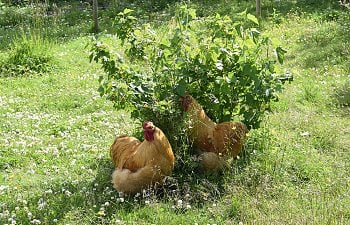
Back To The Roots
In the wild, a rooster's job is to protect the flock. He guides the hens to food sources, finds good nest spots for his hens, warns about enemies from the ground and air, and of course, fertilizes the eggs.
Imagine if a wild rooster spent all his time mating the hens. Not only would he be distracted from looking for predators, but he'd also spend an enormous amount of energy on a useless activity (Yes, useless, a hen collects the sperm inside and can store it for weeks. Ergo, mating her a couple of times a day should be more than sufficient), and even hinder the hens from feeding and possibly injuring them by ripping out their feathers. Does that sound productive?
A wild rooster would not pick fights with everyone and everything. In the entire animal kingdom, males tend to avoid fighting at all costs. They've developed elaborate displays of horns, colors, and dances to measure strength without resorting to physical violence. Every fight is a risk for injuries, even for the winner. The expression "pick your battles" is rule number one for animals in the wild. A wild rooster doesn't have access to antibiotics, bandages, or pain killers, and while waiting for his wounds to heal, his flock is without his protection.
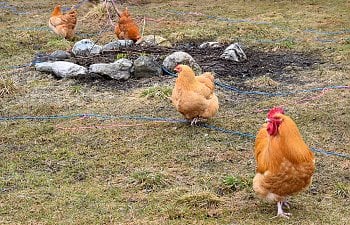
Buffulf being a good protector, walking first. The ladies trust him and follow along.
Crowing
Crowing functions as a call to the flock to get up and start moving (it's 6 am, time for breakfast), to locate members of the flock (marco – polo) and a means to warn other chicken flocks nearby of their presence (yo, neighbor, I'm over here!). Crowing attracts predators, so every time a rooster crows, it's a potential risk. This is actually used as a way to demonstrate strength, not only by roosters but other birds as well. A bird who's not afraid to call out his presence is one that's confident he'll escape any predators that come his way. Ergo, the ladies see a crowing rooster as a healthy specimen.
The rooster's crowing is one of the most significant behaviors that set the domestic chicken apart from its ancestors. The domestic rooster crows quite frequently, loud and long, whereas the RJF is satisfied with a quick morning wake-up call. It might be difficult to see with today's consumption of eggs and chicken, but it's believed that food was not the primary reason for the domestication of chickens. They were used for cockfighting, ceremonial purposes, and even ornamental. The rooster was revered in many ancient cultures, for his bravery and protection skills and for his morning crow. The rooster's crow was considered a good start of the day, and a noble sound. They therefore unconsciously selectively bred roosters to crow both more and longer. It's a bit sad to think that a crow that was once revered, now is looked upon as a pest. The rooster crows due to an internal clock, but also in relation to light and nearby crowing, meaning that this behavior is a cause of both genetic markers and external stimuli.
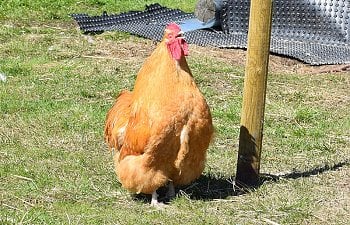
Crowing. Roosters love it, neighbors hate it.
Genetically encoded behavior
I feel that a lot of people tackle the aggression and "misbehaving" in roosters from the wrong end. What if the rooster wasn't aggressive or misbehaving in the first place? A lot of behaviors are encoded in the DNA. Animals do the strangest things (in our eyes) without no one telling them to do so. Grebe ducks feed their young down feathers as a first meal in order to help the duckling digest fish bones. Does momma duck remember that she was fed feathers when she was just a day old when it's time for her to have her first batch of ducklings? Probably not. The likelier explanation is that this specific action is encoded in their DNA. With that in mind, it's easy to understand how rooster behavior is also much down to genetics. If the rooster is the offspring of a line of calm and naturally acting roosters, it's likely to also act calm and natural.
Here's a digression in the field of genetically transferred temperament: There's a line of English Pointers descended from a dog called Appalachian Annie, that's referred to as "nervous pointers". Annie was a fearful and shy dog in all ways. A group from the University of Arkansas acquired Annie and started selectively breeding fearful dogs by choosing the most nervous dogs in each litter. This was done to research methods of helping with neurosis and anxiety disorder. (Quite terrible, really. Poor dogs.) The result was extremely fearful dogs that panicked around all things new. (Source: "How Dogs Think" by Stanley Coren)
Breeding for looks or temperament
So why not just breed for calm and naturally behaving chickens? It's not as simple as that. Poultry breed standards focus mostly on exterior looks. There are mentions of temperament, but mostly it focuses on body shape, comb shape, colors, and size. Show breeding is a complex job that I will not even begin to understand. There are many factors involved in choosing the absolute best animals to continue the lines, and I'm not going to pretend to know anything about that.
There's a still ongoing experiment that started in 1959 in Russia with the goal of domesticating red foxes. The experiment is simple: take the tamest and calm individuals from each litter, and breed them. The result was interesting. After umpteen generations, the foxes were fundamentally different in temperament, but also physical appearance. There were specific morphology towards more juvenile traits and also physical changes in fur color, which included white-spotted patches. The reason this is important to poultry breeding is that it shows just how complex genes are. The researchers only had one criterion in their breeding; tameness. Yet, there were a lot of physical changes. As you can see, there is no way to breed only for temperament, and retain all the physical traits from the parent generation. There has to be a compromise to get both the exterior look described in the breed standard and natural temperament.
Unfortunately, not all breeders focus on temperament. Big hatcheries want to churn out as many baby chicks as possible and breed for quantity. Backyard mix breeds can be bred for their strange looks or egg color only. For those with a small flock of mix-breeds who have a few babies a year, it's an excellent chance to breed for temperament rather than exterior looks.
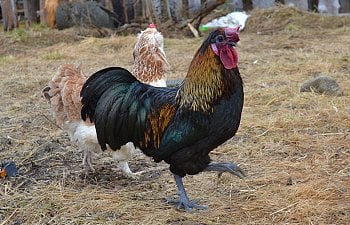
Gorgeous mix rooster, eh? Unfortunately, he was aggressive, so no babies for him.
Some breeders do focus on temperament, but in the other way around, to create cockfighting birds. Luckily, this "sport" is illegal in most places.
Body language - it's all in the details
In order to assess genetic temperament, one must spend considerable time watching adult individuals go about their day in a natural environment. Adolescents tend to behave erratic and aggressive because they're trying to find their place in the flock and don't yet show their true genetic make-up in terms of behavior. Mistreated and abused animals are very difficult to assess for true temperament. A rooster that's been kicked, chased, hurt, or egged on for fighting will be cautious and aggressive no matter what his genes tell him.
Watching adults for temperament is a useless activity if you don't know what to look for. How do chickens talk? Chickens and other poultry can't speak the human language. They do speak to each other using sounds, but their main form of communication is through body language. Once you start focusing on that while watching the birds roam around, a whole new world opens up. They don't use big letters, but small, almost insignificant movements of their body. A head turned away when a superior bird approaches: "I want no trouble". Bigger movements like cockerels stretching their necks to peck another one in the comb are more obvious: "I'm bigger than you".
Going back to what I wrote about wild birds not wanting to fight, watching roosters in the same flock communicate says a lot about how in tune they are with natural behavior. Learn what dominating and calming body signals a rooster sends off. Some dominating signals are; dropping wings and dancing around male challengers (as opposed to doing the same to hens, then he's flirting with them), walking straight at challenger with head high, and, obviously, attacking.
Some calming signals are; turning either head or body away from the challenger, cowering, and displacement behavior like pecking the ground for food, clucking, and drinking.
A good alpha-rooster will use mild dominating signals first, and only escalate if his submissor doesn't give way. He will also stop his dominant display when the other roo shows his respect. A good lower-ranking roo will use clear submissive signals consistently.
This is a sequence from a video I shot. Buffulf the boss (left) approaches Orpulf head-on. Orpulf turns away immediately. Buffulf starts pecking on the ground and calling the hen towards him. It's a good example of clear and non-aggressive body language.
The need for space
Both hens and roo's use running away/retreating to avoid conflict. Overcrowding or small living quarters will prevent them from doing so. Hens won't be able to say no to their roo's mating suggestion, resulting in them being forced into a corner and overpowered.
Small space is particularly bad with more than one rooster in the same pen. Younger roos will use cunning tactics to lure the hens away to mate them, and if the dominant roo sees them, he will chase. The young rooster's natural response is to move quickly away, as a sign of submission. In an open field, this will happen peacefully and without injury. In a small space, the youngling will be prevented from expressing himself correctly and is left standing in the same place, which is a sign that he wants to challenge the boss. Fighting in small spaces can have terrifying results. Seeing as retreating is their language for "I give up!", having the loser pinned into a corner not being able to move could result in death. This doesn't have to mean the winner is particularly aggressive, he has misunderstood the loser's body language. Chickens need space to be able to perform their natural communication.
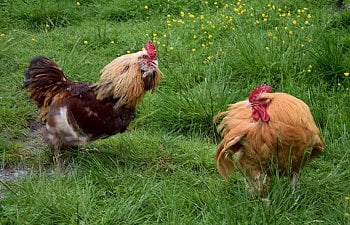
Orpulf retreating after a fight with the new boss in town, Theodore Roostervelt.
Human handling and its effects on behavior
Humans are obviously not part of the chicken's natural environment. However, in a backyard situation, you should be able to walk amongst, pick up and have contact with the roo. Any contact, good or bad, can mask their natural, genetic behavior, so be sure to keep a distance to take that out of the equation when assessing your rooster.
I'm a zoo-keeper and therefore need to be around both wild and domesticated animals. When it comes to handling animals in general, there are some important, yet simple rules to follow.
1. Be respectful
Animals are egocentric by nature, their own personal well-being is their top priority. For mothers and leaders of a flock, this extends to protecting their resources, meaning offspring and harem. It's easy to get annoyed by individuals who just won't cooperate but always look at the situation through THEIR eyes.
2. Don't anthropomorphize
Anthropomorphism is to put human characteristics onto animals, including feelings, ways of communication, and behavior. This is a tough one. From childhood, we've been taught the rules of human society, etiquette, and responses, so when we see similar behavior in animals we automatically assume it means the same. Don't fall into that trap! Ever seen one of those adorable pictures of a smiling orangutan? Actually, that's an expression of fear. Each different species have their own way of communicating. Even comparing the behavior of one gender within the same species to the other can lead to misunderstandings. When dealing with a new kind of animal species, the best thing is to be accompanied by someone who knows them. At the very least read up on their behavior beforehand.
3. Appear non-threatening
When approaching any animal you don't know, be calm. Stand with your side to the animal, don't look directly at them, and move slowly. Walking straight ahead and looking them dead in the eye is a universal sign of dominance. For smaller animals like a chicken, kneeling or sitting is a good idea, as it will reduce your size. Talking in a soft voice can help too. Let the animal come to you and stand still while it investigates.
4. Be consistent
Changes cause stress, and stress causes difficulty in handling animals. Repetitive behavior is the best way to teach animals something, such as walking into the coop at night. Sudden changes in your behavior towards them will only serve to create confusion, fear, and aggression.
5. Use positive reinforcement
Positive reinforcement means to reward good behavior with something the animal wants, most often treats and praise. It's the most effective way to train an animal. You can use it alone or in league with other training methods (though I do not recommend using physical violence). When an animal does an unwanted behavior and then stops, always reward. It will teach them not doing the unwanted behavior is favorable.
The Good Rooster
As mentioned earlier, a good rooster is a protector, guide, and fertilizer. A good rooster does all this while treating his girls nicely. He flirts and dances with them before mating, he gives them the best treats and he comes running when a hen calls out. The hens trust him and will follow him around. He also treats the submissive roosters in the flock with respect and acknowledges their contribution to the flock by being extra lookouts.
If this sounds like your rooster, congratulation! You have a naturally behaving rooster!
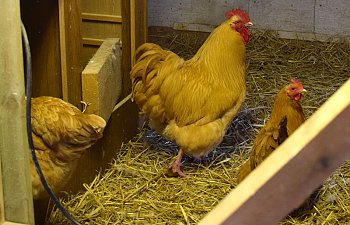
Buffulf following a hen to her nest spot.
The Not So Good Rooster
If not, it may be possible to help him act better. Just remember: he's not being evil, just following his instinct and reacting to the environment. To begin: No, you don't have to dominate or assert yourself as your rooster's boss. You're not a rooster, and you don't want to be looked upon as a rooster. A certain amount of imprinting and familiarizing is unavoidable in a backyard situation, so reading up on the body language he'll use towards you is a must. (See links at the bottom of the article.)
The best thing to do when being attacked is to de-escalate the situation with positive reinforcement, and then try to understand why it happened. Did you surprise him, appear challenging, or maybe you were feeding his best girl? Staying cool and thinking will help you understand his motivation so aggression can be avoided in the future.
Interrupting a rooster mid-mating because you think he's being disrespectful to the ladies or challenging you as the leader will confuse both of them. Chickens have no prudence when it comes to sexuality. For them, sexual behavior is the most natural thing in the world, and they're not going to hide behind a bush. Handling over-mating should involve separation, giving them more space so the hen can walk away, not actively throwing roosters off hens' backs.
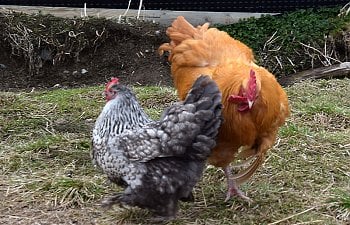
Orpulf showing how rooster courtship should work by dancing to ask for permission. Alas, no luck this time as the hen goes away instead of squatting.
Summary
Roosters are not supposed to be overly aggressive, over-mating, or crowing all the time. An aggressive individual can be helped to calm down with proper training, but if he's mated, he'll pass those malfunctioning genes to the next generation. The only way to truly get calm and naturally behaving roos is to breed them and only them. On a final note: The hens' temperament also matters. They can also be aggressive and high strong (it's not just a man-thing), and that will transfer to her male offspring as well.
Naturally behaving, good roosters are a joy to have and watch, and I hope more people get to experience the wonderful sides of 50% of the chicken population.
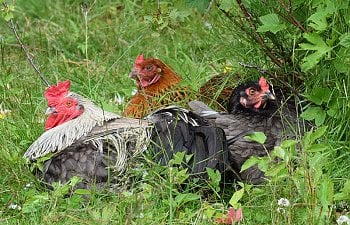
Sources and links
https://www.backyardchickens.com/articles/understanding-your-rooster.75056/
Just read this, you'll be glad you did.
Sophisticated Fowl: The Complex Behavior and Cognitive Skills of Chickens and Red Junglefowl
Relatedness and age reduce male interactions over mating in domestic fowl
The Chicken Challenge
Section 1 and 2 deals with chicken communication
Why Did the Chicken Cross the World?: The Epic Saga of the Bird that Powers Civilizations (Google preview of the book)
